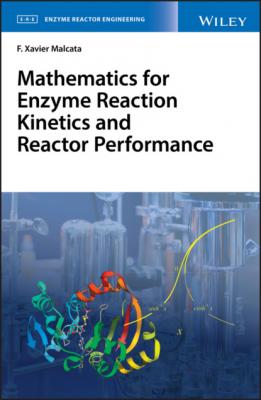Mathematics for Enzyme Reaction Kinetics and Reactor Performance. F. Xavier Malcata
Читать онлайн.| Название | Mathematics for Enzyme Reaction Kinetics and Reactor Performance |
|---|---|
| Автор произведения | F. Xavier Malcata |
| Жанр | Химия |
| Серия | |
| Издательство | Химия |
| Год выпуска | 0 |
| isbn | 9781119490333 |
(2.477)
based on Eq. (2.473) – with derivation rules to be introduced in due course.
Figure 2.14 Variation, with their argument x, of major hyperbolic functions, (a) hyperbolic sine (sinh) and cosine (cosh), (b) hyperbolic tangent (tanh) and cotangent (cotanh), and (c) hyperbolic secant (sech) and cosecant (cosech).
On the other hand, ordered addition of Eqs. (2.472) and (2.473), viz.
(2.478)
along with cancelation of symmetrical terms lead to
while ordered subtraction of Eq. (2.472) from Eq. (2.473) yields
(2.480)
since ex /2 cancels out with its negative – or simply
Equations (2.479) and (2.481) are expected, in view of cosh x being an even function and sinh x being an odd function – as per Eqs. (2.474) and (2.475), respectively, coupled with Eq. (2.1).
The remaining functions of practical interest include the hyperbolic tangent, tanh x, defined as
– at the expense of Eqs. (2.472) and (2.473), after dropping 2 from both numerator and denominator; as well as its reciprocal, the hyperbolic cotangent, cotanh x, according to
with the aid of Eq. (2.482) – both of which are depicted in Fig. 2.14b. Note the monotonically increasing pattern of tanh x, with
(2.484)
serving as leftward horizontal asymptote based on Eq. (2.482), complemented by
(2.485)
serving as rightward horizontal asymptote; along with the decreasing behavior of cotanh x, despite the discontinuity at x = 0, i.e.
(2.486)
stemming from Eq. (2.483) – which accordingly justifies why the vertical axis plays the role of vertical asymptote.
By the same token, the hyperbolic secant, sech x, abides to
after resorting to Eq. (2.473); while the corresponding hyperbolic cosecant, cosech x, looks like
once Eq. (2.472) is retrieved – and as plotted in Fig. 2.14c. When x approaches zero, the hyperbolic cosecant is driven by
(2.489)
arising from Eq. (2.488), so x = 0 plays the role of vertical asymptote for this function; as for the remaining values, cosech x monotonically decreases within]−∞,0[ and also within]0,∞[, as can be grasped in Fig. 2.14c. Conversely,
(2.490)
based on Eq. (2.487) – so the horizontal axis serves as horizontal asymptote toward −∞, whereas
(2.491)
indicates that the very same straight line serves as (horizontal) asymptote toward ∞. In this case, there is a maximum at x = 0 – since d sech x/dx = −2(ex − e−x)/(ex + e−x)2 (to be fully proven at a later stage) equals zero when ex = e−x, or else at x = 0; this critical point is easily perceived in Fig. 2.14c. Finally, note the resemblance between the functional form of Eqs. (2.482) and (2.483) with Eqs.
